Scottish household survey 2015: annual report
Report presenting reliable and up-to-date information on the composition, characteristics and behaviour of Scottish households.
8 Internet
8.1 Introduction and Context
The Scottish Government is committed to ensuring that all of Scotland is well positioned to take full advantage of all opportunities offered by the digital age. This includes a vision of a Scotland where businesses and individuals are making effective use of the digital infrastructure available to them, and where digital technology is supporting economic growth, social cohesion and future innovation [48] .
Part of the Scottish Government's Digital Strategy [49] is to increase digital participation. Digital participation refers to people's ability to gain access to digital technology and use it effectively and creatively. Being able to use the internet provides access to a range of political, educational, cultural and economic resources and is thereby an important facilitator of social inclusion. Ultimately, increased digital participation can improve people's quality of life, boost economic growth and allow for more effective delivery of public services. This year's Scottish Household Survey ( SHS) is the first to include more detailed measures of digital participation.
The SHS provides information on a number of relevant areas of digital participation that can be used to measure progress. This chapter begins by looking at take-up of internet and broadband by households in Scotland, with a focus on how this varies by income and area. It then looks at personal use of internet - including frequency of use as well as where and how the internet is accessed - by key demographic factors, such as age and gender, health status, income and deprivation. Lastly, there is coverage of some more specific use, in order to understand the activities for which the internet is being used and how confident users are undertaking different activities. The third section looks at the reasons why adults do not use the internet and at use of Government and local authority websites to access information and services.
The 2015 SHS included two new questions related to online security which were asked of those who make personal use of the internet. These are presented in the final part of the chapter.
Main Findings
Eighty per cent of Scottish households reported having internet access at home in 2015, unchanged from 2014. Home internet access has increased over the past decade from 42 per cent in 2003. The vast majority of households with internet access at home reported having a broadband connection (98 per cent). Across all households (both households that have access to the internet and those who do not), 79 per cent had broadband at home.
Around one in five (18 per cent) of adults report not using the internet at all, in line with last year's figure.
Sixty per cent of households with incomes of £15,000 or less had home internet access, increasing to 98 per cent of households with incomes over £40,000.
Gaps in internet access and use remain amongst certain groups including those in deprived areas, those in social housing and those on low incomes. In terms of access, there has been no significant change by most measures (income, deprivation and tenure) from 2014.
Methods used to access the internet are continuing to change. Methods other than a personal computer or laptop have continued to increase, rising to 81 per cent in 2015, whilst personal computer/laptop use continued to fall, decreasing to also stand at 81 per cent. The rise in use via methods other than personal computers or laptops is overwhelmingly due to tablets and mobile phones.
The most common activities undertaken by those who have access to the internet include sending and receiving emails (91 per cent) and searching for information (88 per cent).
Among those that have access, a lower proportion of adults in social housing were very or fairly confident than those in private rented housing in their ability to use the internet for all purposes including using public services online, shopping on line and being able to tell which websites to trust. Those aged over 60 and those on incomes between £10,000-£20,000 consistently reported being less confident than average.
Not liking or not needing to use the internet or computers remain the main reasons for not using the internet.
In 2015, 38 per cent of adults reported that they had used a Local Authority website for any purpose whilst 18 per cent reported that they had used a Government website for any purpose. The most common use for Local Authority and Government websites in 2015 was looking for information (30 per cent and 15 per cent respectively).
The main perceived benefits of public service websites were the time savings (89 per cent of adults who used a public sector website). Eighty-six per cent of these adults were fairly or very satisfied with the overall quality of the public services they had used online, and 81 per cent responded that they were fairly or very satisfied with the ease of finding information.
The 2015 SHS asked respondents for the first time about security measures they take to protect themselves when online, with results showing some preventative actions are adopted much more commonly than others. For instance, whilst 66 per cent of respondents said they avoid opening emails or attachments from unknown people, just under a third (31 per cent) regularly change their passwords for online accounts. Those aged 75 and above were most likely to say they took none of the suggested precautions, with 21 per cent selecting this answer in comparison to 3 per cent of those aged 25-34.
8.2 Household and Internet Broadband Take-Up
8.2.1 Internet Access
The SHS has asked whether households currently have access to the internet from their home every year since 2003. In 2015, the proportion of households with home internet access remained at 80 per cent (Figure 8.1) having increased gradually year on year from 42 per cent of households surveyed in 2003.
Figure 8.1: Households with home internet access by year
2003-2015 data, Households (minimum base: 3,270)
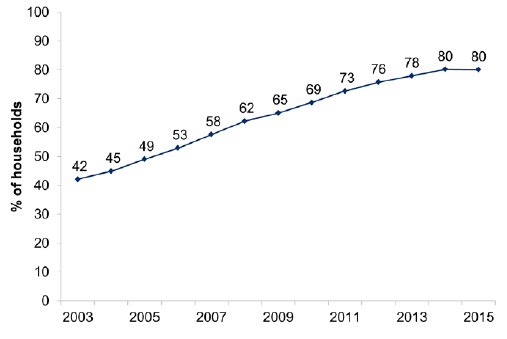
Home internet access tends to increase with household income (Figure 8.2) although a break in the pattern for income bracket £6,001-£10,000 is present year on year. Students are overrepresented in the lowest income bracket, £0 - £6,000, (making up almost a quarter of it) and are very likely to have internet access at home (93 per cent). The bracket also contains a lower proportion of the permanently retired (of whom only 58 per cent have access) than the £6,001 - £10,000 and £10,001 - £15,000 bands which may explain the higher figure. In 2015, 60 per cent of households with incomes of £15,000 or less had home internet access, increasing to 98 per cent of households with incomes over £40,000.
Figure 8.2: Households with home internet access by net annual household income
2015 data, households (minimum base: 80)
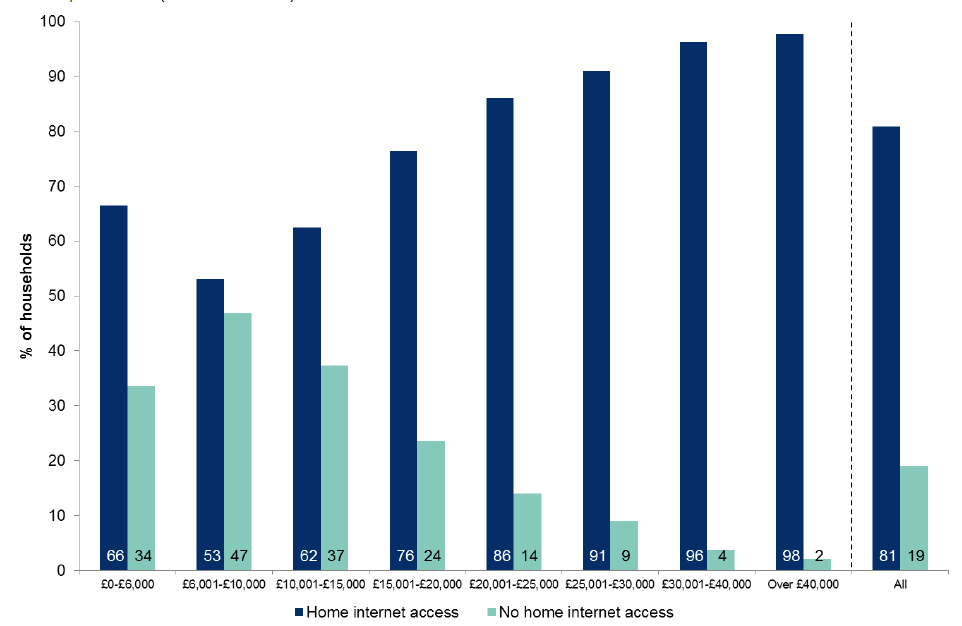
Figure 8.3 shows that households in the 20 per cent most deprived areas [50] in Scotland continue to be less likely than those in the rest of Scotland to have access to the internet at home, the proportion with access being 71 per cent and 82 per cent respectively.
Figure 8.3: Households with home internet access by Scottish Index of Multiple Deprivation ( SIMD) 20 per cent most deprived areas
2015 data, Households (minimum base: 610)
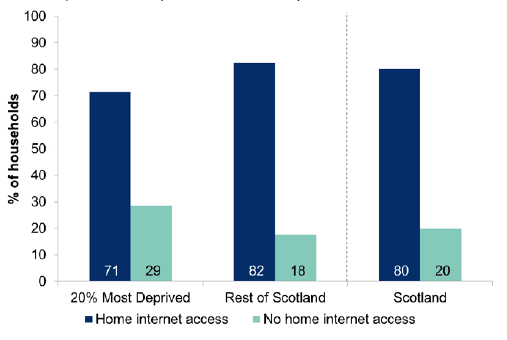
Figure 8.4 shows that that internet access varies by tenure, with 85 per cent of households who own their home having home internet access, compared to 88 per cent of those in private rented housing and only 62 per cent of those in social rented housing.
Figure 8.4: Households with internet access at home by tenure
2015 data, Households (minimum base: 40*)
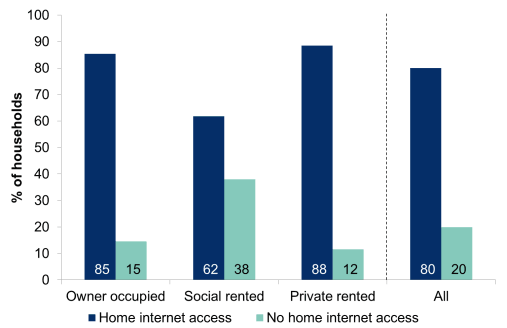
*The category with the minimum base is not shown in the chart because the size of the sample for that category means that the figures have been suppressed
Figure 8.5 shows the prevalence of home internet access by area, based on Urban Rural Classification [51] . The proportion of households with home internet access remained highest in accessible rural areas (85 per cent).
Figure 8.5: Households with home internet access by Urban Rural Classification
2015 data, Households (minimum base: 190)
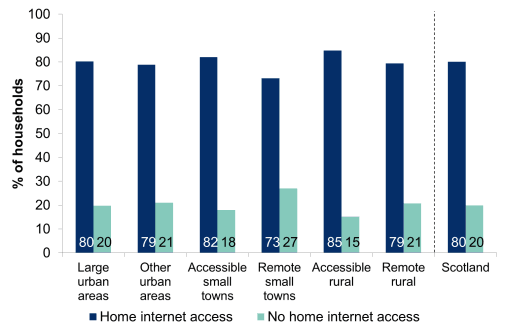
Since 2007, the SHS has asked households who reported having access to the internet at home if they have a broadband connection [52] . The vast majority of households with internet access at home had broadband in 2015 (98 per cent). The proportion of households with access to the internet through a broadband connection has risen from 87 per cent since 2007. Across all households (that is, both households that have access to the internet and those who do not), 79 per cent had broadband at home in 2015.
There appears to be very little difference in broadband uptake among households who had internet access at home depending on the level of rurality and little variation by income, tenure or deprivation, all of which sit at the mid to high 90 per cent mark.
8.2.2 Internet Use
In addition to the questions on household take-up of internet and broadband, the SHS asks a randomly selected adult in the household whether they use the internet either for work or personal use. Overall, 82 per cent of adults said that they used the internet in 2015 for work or personal use, with 18 per cent stating that they did not use the internet at all. Under 1 per cent said that they only used it for work purposes.
The following section mainly focuses on those who do not use the internet at all. In order to increase digital participation and enable more people to enjoy the benefits that the internet can offer, it is important to identify if there are any groups of people that face barriers accessing or using the internet. In particular, this section looks at those who do not use the internet by age, health, income, level of deprivation and tenure. It then looks at use in more detail by tenure.
Figure 8.6 shows that there is a clear relationship between age and use of internet with significantly lower rates of internet use among older people. Around 4 per cent of adults aged 16 to 44 reported not using the internet, whereas the figure for those aged 75 and over is 70 per cent, although this latter figure has fallen from 76 per cent in 2014.
There was no significant difference in internet use between genders.
Figure 8.6: Use of internet by age
2015 data, Adults (minimum base: 380)
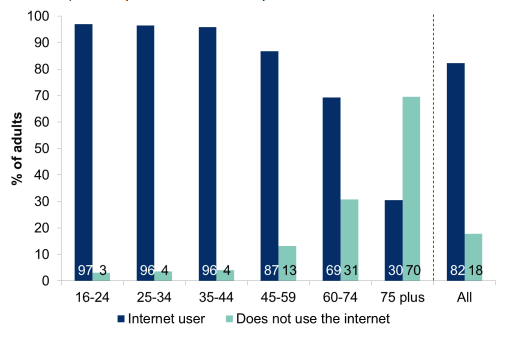
Thirty five per cent of those who have some form of a longstanding physical or mental health condition or illness reported not using the internet compared with 11 per cent of those who do not have any such condition (Table 8.1). The result remains more marked among the older age groups but is prevalent across age bands
Table 8.1: Proportion of adults who do not use the internet by age and whether they have a physical or mental health condition lasting or expecting to last 12 months or more
Column percentages, 2015 data
| Does not have a physical or mental health condition or illness | Has a physical or mental health condition | All | |
|---|---|---|---|
| 16-24 | |||
| Internet user | 98 | 92 | 97 |
| Does not use the internet | 2 | 8 | 3 |
| Base | 330 | 50 | 380 |
| 25-34 | |||
| Internet user | 97 | 94 | 97 |
| Does not use the internet | 3 | 6 | 3 |
| Base | 460 | 90 | 540 |
| 35-44 | |||
| Internet user | 97 | 89 | 96 |
| Does not use the internet | 3 | 11 | 4 |
| Base | 530 | 120 | 650 |
| 45-59 | |||
| Internet user | 90 | 79 | 87 |
| Does not use the internet | 10 | 21 | 13 |
| Base | 850 | 390 | 1,240 |
| 60-74 | |||
| Internet user | 76 | 60 | 69 |
| Does not use the internet | 24 | 40 | 31 |
| Base | 660 | 530 | 1,190 |
| 75+ | |||
| Internet user | 39 | 25 | 31 |
| Does not use the internet | 61 | 75 | 69 |
| Base | 230 | 370 | 610 |
| All | |||
| Internet user | 89 | 65 | 82 |
| Does not use the internet | 11 | 35 | 18 |
| Base | 3,050 | 1,550 | 4,600 |
Excludes 'Don't know'/'Refused' statements
Figure 8.7 shows that, as with internet access, there is a broadly positive relationship between internet usage and income with a break in the trend for the lowest income bracket - this feature of income is discussed in the internet access section above. Three per cent of adults living in a household with a total net income of £40,000 or more did not use the internet in 2015 compared with 37 per cent of those in the £6,001-£10,000 bracket.
Figure 8.7: Use of the internet by net annual household income
2015 data, Adults (minimum base: 120)
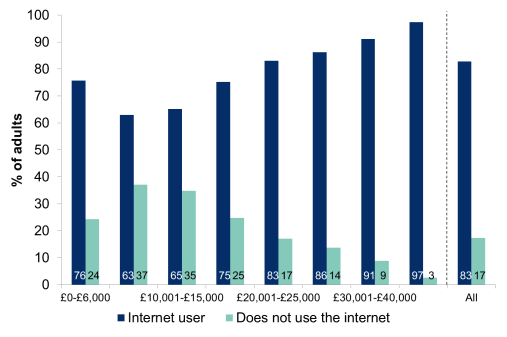
As with internet access, there is a difference in internet usage by deprivation (Figure 8.8). Twenty six per cent of adults living in the 20 per cent most deprived areas in Scotland reported not using the internet compared with 16 per cent in the rest of the country.
Figure 8.8: Use of the internet by Scottish Index of Multiple Deprivation ( SIMD) 20 per cent most deprived areas
2015 data, Adults (minimum base: 870)
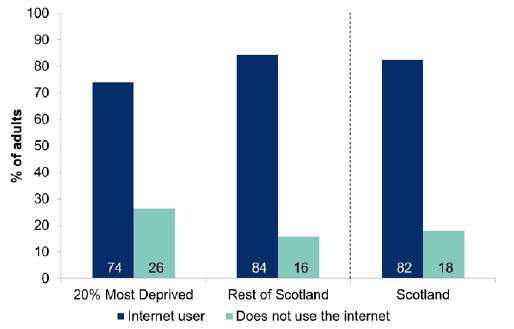
Figure 8.9 shows that there was a significant difference in internet use by tenure. Thirty two per cent of those in social rented housing reported not using the internet compared to only 6 per cent of those in private rented housing and 15 per cent of those that own their own homes.
Figure 8.9: Use of the internet by tenure
2015 data, Adults (minimum base: 60)
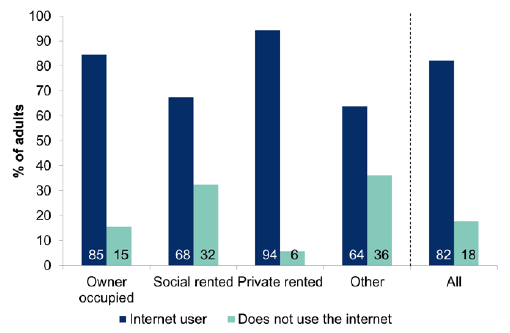
Eighty six per cent of all adults with internet connections use the internet every day (Figure 8.10). This decreases with age, to 51 per cent of those aged 75 plus. The large gender differences in everyday use among the 75 plus band in 2014 are no longer present in 2015 as men in this category are reporting that they use the internet less frequently than in 2014. Ninety three per cent of adults with incomes of £40,001 and over report using the internet every day.
Figure 8.10: Frequency of internet use by age
2015 data, Adults (minimum base: 110)
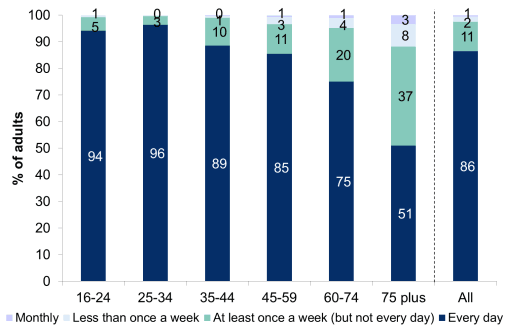
8.3 Where and How Users Access the Internet
The ways in which people access the internet are becoming increasingly diverse. Since 2007, the SHS has asked adults who use the internet for personal use about the location where they access it and the methods they use. Almost all adults (97 per cent) said that they use the internet at home (Table 8.2). Those reporting that they access the internet on the move using a mobile phone or tablet (45 per cent in 2015) has continued to rise, increasing by 4 percentage points since 2014. Over a quarter (28 per cent) said that they make personal use of the internet at work.
The inverse relationship observed between age and accessing the internet on the move remains.
There is also a relationship between household income and where users access the internet for personal use, with the proportion of people accessing the internet on the move or at work, for the most part, increasing with income. Internet use on the move in the £6,001-£10,000 income band rose by 13 percentage points from 2014.
Table 8.2: Where adults who use the internet access it for personal use by annual net income
Column percentages, 2015 data
| Adults who make personal use of the internet | £0-£6,000 | £6,001-£10,000 | £10,001-£15,000 | £15,001-£20,000 | £20,001-£25,000 | £25,001-£30,000 | £30,001-£40,000 | Over £40,000 | All |
|---|---|---|---|---|---|---|---|---|---|
| At home | 87 | 90 | 93 | 96 | 99 | 98 | 96 | 99 | 97 |
| On the move via a mobile phone/smartphone/tablet | 36 | 40 | 34 | 41 | 41 | 49 | 44 | 55 | 45 |
| At work | 11 | 7 | 10 | 20 | 21 | 25 | 33 | 46 | 28 |
| At another person's home | 8 | 13 | 11 | 13 | 13 | 16 | 13 | 16 | 14 |
| School, college, university, other educational institution | 31 | 13 | 10 | 7 | 7 | 3 | 5 | 9 | 8 |
| Internet café or shop | - | 4 | 4 | 7 | 2 | 2 | 4 | 5 | 4 |
| Public library | 3 | 10 | 6 | 4 | 2 | 2 | 4 | 3 | 4 |
| Somewhere else | 1 | 2 | 1 | - | 1 | 2 | 1 | 2 | 1 |
| Community or voluntary centre/organisation | - | 0 | 0 | - | 0 | 0 | 0 | 2 | 1 |
| A government/council office | 0 | 0 | 0 | 1 | 0 | 1 | 1 | 1 | 1 |
| Don't know | - | - | 0 | - | - | - | - | - | 0 |
| Base (minimum) | 50 | 150 | 340 | 310 | 270 | 230 | 370 | 510 | 2,230 |
Table 8.3 shows which methods are used to access the internet for personal use by age. The proportion of adults reporting that they access the internet using personal computers or laptops is continuing to decrease, from 87 per cent in 2014 to 81 per cent in 2015. Conversely, the proportion of adults accessing the internet by means other than a personal computer or laptop (including tablets and mobile phones) is continuing to increase, from 74 per cent in 2014 to 81 per cent in 2015. There is very little change in access by means other than a personal computer or laptop among 25-34 year olds, where uptake was already very high in 2014. 16-24 year olds are accessing the internet more through television. However there are substantial increases in access by these 'other' means of 18 and 22 percentage points among 60-74 year olds and those aged 75 plus respectively. The 'other' technologies used are overwhelmingly tablets and mobile phones amongst all age brackets. However, among 35-59 year olds, this is tilted more towards phones, whereas for those over 60, tablets are the main driver of the change.
Table 8.3: Where adults who use the internet for personal use access it by age
Column percentages, 2015 data
| Adults who make personal use of the internet | 16-24 | 25-34 | 35-44 | 45-59 | 60-74 | 75 plus | All |
|---|---|---|---|---|---|---|---|
| A personal computer or laptop | 73 | 74 | 80 | 86 | 87 | 81 | 81 |
| Digital, cable or satellite television | 15 | 15 | 12 | 12 | 3 | 5 | 11 |
| Mobile phone/iPhone/Smartphone | 90 | 86 | 79 | 67 | 36 | 19 | 69 |
| A games console/ PS2/xBox | 23 | 15 | 11 | 6 | 1 | 1 | 10 |
| A tablet - iPad/Playbook or similar | 40 | 45 | 52 | 52 | 48 | 40 | 48 |
| Another way | 0 | 2 | 0 | 1 | 1 | - | 1 |
| Other than a personal computer or laptop | 94 | 90 | 88 | 78 | 61 | 50 | 81 |
| Base (minimum) | 230 | 340 | 420 | 670 | 510 | 110 | 2,280 |
As shown in Table 8.4, the most common activities undertaken by those who have access to the internet include sending and receiving emails (91 per cent of all adults who make personal use of the internet), searching for information (88 per cent), buying goods or services (76 per cent), using social media (67 per cent) and internet banking (59 per cent). Those renting private housing were more likely than average to use the internet for making telephone/video calls and looking/applying for jobs. Those in social rented housing were less likely than average to use the internet for banking and buying goods and services.
Table 8.4: Which methods are used to access the internet for personal use by tenure
Column percentages, 2015 data
| Adults who make personal use of the internet | Owner occupied | Social rented | Private rented | Other | All |
|---|---|---|---|---|---|
| Send and receive e-mails | 93 | 83 | 91 | * | 91 |
| Search for information | 89 | 82 | 90 | * | 88 |
| Buy goods or services | 78 | 62 | 76 | * | 76 |
| Use social media | 63 | 73 | 75 | * | 67 |
| Internet banking | 62 | 43 | 64 | * | 59 |
| Play or download games, films or music | 49 | 53 | 55 | * | 51 |
| Make telephone/video calls over the internet | 38 | 36 | 58 | * | 41 |
| Look for/apply for jobs | 24 | 32 | 40 | * | 28 |
| Create websites or blogs | 10 | 4 | 19 | * | 11 |
| None of these | 1 | 2 | 0 | * | 1 |
| Base (minimum) | 1,520 | 420 | 320 | 30 | 2,280 |
Among those that have access, a lower proportion of adults in social housing were very or fairly confident than in private rented housing in their ability to use public services online, shop online, know which websites to trust, identify and delete spam, send emails, control privacy settings, send and receive emails and use a search engine (Table 8.5). Those aged over 60 and those on incomes between £10,000-£20,000 consistently reported being less confident than average across all activities.
Table 8.5: Confidence in pursuing activities when using the internet by tenure
Column percentages, 2015 data
| Adults who make personal use of the internet | Owner occupied | Social rented | Private rented | Other | All |
|---|---|---|---|---|---|
| Send and receive e-mails | 93 | 86 | 95 | * | 92 |
| Use a search engine | 96 | 92 | 99 | * | 96 |
| Shop online | 88 | 77 | 91 | * | 87 |
| Use public services online | 86 | 69 | 89 | * | 84 |
| Identify and delete spam | 83 | 73 | 88 | * | 83 |
| Be able to tell what websites to trust | 80 | 73 | 88 | * | 81 |
| Control privacy settings online | 74 | 74 | 85 | * | 76 |
| Base (minimum) | 1,470 | 390 | 310 | 20 | 2,190 |
8.4 Why People Do Not Use the Internet
The SHS asked adults who make no personal use of the internet why they do not (Table 8.6).
Not liking or not needing to use a computer remain the main reported reasons for not using the internet. The most significant change since last year is the increase in those reporting that they prefer to do things in person rather than use a computer (from 5 per cent in 2014 to 8 per cent in 2015).
Table 8.6: Reasons why people might not use the internet (other than work)
Column percentages, 2015 data
| Adults who make no personal use of the internet | |
|---|---|
| I don't like using the internet or computers | 40 |
| I don't need to use the internet or computers | 33 |
| I can't afford a computer | 9 |
| Internet connection would be too expensive | 4 |
| It would be too difficult to learn how to use the internet | 10 |
| There's nothing of interest to me on the internet | 16 |
| I don't know how to use a computer | 19 |
| I prefer to do things in person rather than use computers | 8 |
| I have a disability or illness that prevents me | 3 |
| I am concerned about privacy e.g. keeping credit card or personal details safe | 2 |
| I am worried about unsuitable or inappropriate material on the internet | 1 |
| Other reason | 4 |
| Base (minimum) | 770 |
8.5 Use of Local Authority and Government Websites
It is possible to access an increasing number of public services and information online. Online services can be quicker and more convenient for people to use, and can be provided at a lower cost than other methods. However, a person's use of websites to access public services is dependent both upon internet access and their tendency to access information or services online. The SHS explores people's use of digitally delivered public services by asking which, if any, things the respondent has ever used their local council website and (non-specified) government websites for.
Table 8.7 presents the proportions of internet users who, in 2015, reported having ever used a local council or government website. It should be noted that these figures do not take into account whether people have actually needed to access information or use these services in the first place.
Because of changes to the structure of the questions in the 2015 survey, results are not directly comparable to 2014. In 2015, 38 per cent of adults reported that they had used a Local Authority website for any purpose whilst 18 per cent reported that they had used a Government website for any purpose. The most common use for Local Authority and Government websites was looking for information (30 per cent and 15 per cent respectively). Figures are also available on a broader range of public services websites. Of these, NHS (including GP or Dentist) websites were used in the highest proportion with 28 per cent of adults having used them. Sixteen per cent of adults had used the VisitScotland website. Thirty five per cent of internet users had used none of the public services websites.
Table 8.7: Use (ever) of public services on the internet
Column percentages, 2015 data
| Adults | Internet users | All adults |
|---|---|---|
| Local authority website | ||
| Any purpose | 46 | 38 |
| Look for information | 37 | 30 |
| Download forms | 6 | 5 |
| Send completed forms | 3 | 2 |
| Ask a question | 5 | 4 |
| Make a complaint | 3 | 2 |
| Access services like report a fault, renew library books, planning application | 5 | 4 |
| Make a payment (council tax etc) | 6 | 5 |
| Apply for a job | 2 | 2 |
| Apply for funding (housing benefit, legal aid or student funding) | 1 | 1 |
| Report a crime | 0 | 0 |
| Participate in a consultation | 1 | 1 |
| Another reason | 3 | 2 |
| Base (minimum) | 2,390 | 3,160 |
| Government website | ||
| Any purpose | 22 | 18 |
| Looking for information | 15 | 15 |
| Download forms | 2 | 2 |
| Send completed forms | 1 | 1 |
| Ask a question | 1 | 1 |
| Participate in a discussion forum or consultation | 0 | 0 |
| Access services like report a fault, renew library books, planning applications | 0 | 0 |
| Make payment like (council tax etc) | 1 | 1 |
| Apply for a job | 1 | 1 |
| Apply for funding (housing benefit, legal aid or student funding) | 0 | 0 |
| Report a crime | * | - |
| Participate in a consultation | 1 | 1 |
| Another reason | 2 | 2 |
| Base (minimum) | 2,390 | 3,160 |
As shown in Table 8.8, the main perceived benefits of public service websites were the time savings (89 per cent of adults who used a public sector website). Eighty-six per cent of these adults were fairly or very satisfied with the overall quality of the public services they had used online, and 81 per cent responded that they were fairly or very satisfied with the ease of finding information.
Table 8.8: Perceptions of using public services websites
Column percentages, 2015 data
| Accessing public services online helps me save time | 89 |
|---|---|
| Accessing public services online helps me save money | 54 |
| It is easier to access public services online than in person | 78 |
| I am satisfied with the ease of finding information on public services websites | 81 |
| Public services websites are easy to use | 77 |
| I am satisfied with the overall quality of the public services I have used online | 86 |
| Base (minimum) | 1,440 |
Excludes Don't know/Refused responses
8.6 Use of Security Measures
Table 8.9 shows the security measures that people take to protect themselves when online. Across the board, it is clear that some measures are used more commonly than others. For example, two-thirds of adults (66 per cent) indicated that they avoid opening emails or attachments from unknown people, whilst just under a third said they make sure their mobile phone has up-to-date antivirus software (32 per cent) or regularly change passwords for online accounts (31 per cent).
Use of the various online security measures varies by age, with those aged 60 and above generally less likely to adopt each of the measures than those in younger age groups as shown in Table 8.9. In particular, adults aged 75+ were notably less likely to adopt any of the suggested actions. Likewise, whilst 53 per cent of those aged 16-24 said that they back-up important information, this is true for only 33 per cent of those aged 60-75 and 16 per cent of those aged 75 and above.
In addition, adults living in the 20 per cent most deprived areas of Scotland were generally less likely than those in the rest of Scotland to adopt each of the security measures and more likely to say that they took none of the suggested actions. For example, around two-thirds (65 per cent) of those in the rest of Scotland make sure that their computer has up-to-date anti-virus software compared to just under half of those living in the 20 per cent most deprived areas (48 per cent).
Table 8.9: Online security measures by age and deprivation
Column percentages, 2015 data
| Adults | 16-24 | 25-34 | 35-44 | 45-59 | 60-74 | 75 plus | 20% Most Deprived | Rest of Scotland | Scotland |
|---|---|---|---|---|---|---|---|---|---|
| Downland and install software updates/patches when prompted | 60 | 65 | 64 | 61 | 54 | 31 | 49 | 62 | 60 |
| Avoid opening emails or attachments from unknown people | 64 | 71 | 68 | 68 | 63 | 44 | 55 | 69 | 66 |
| Use different passwords for different accounts | 63 | 68 | 62 | 62 | 55 | 34 | 50 | 64 | 61 |
| Set complex passwords | 64 | 56 | 55 | 47 | 40 | 22 | 41 | 53 | 51 |
| Change passwords for onlince accounts regularly | 37 | 36 | 31 | 32 | 24 | 7 | 29 | 32 | 31 |
| Avoid giving personal information online | 67 | 67 | 65 | 65 | 62 | 50 | 54 | 67 | 65 |
| Make sure my computer has up-to-date anti-virus software | 58 | 57 | 65 | 63 | 66 | 59 | 48 | 65 | 62 |
| Make sure my mobile phone has up-to-date anti-virus software | 42 | 40 | 36 | 28 | 20 | 6 | 32 | 32 | 32 |
| Make sure my home wi-fi is protected with a username and password | 58 | 61 | 64 | 58 | 55 | 28 | 45 | 61 | 58 |
| Back-up important information | 53 | 42 | 39 | 38 | 33 | 16 | 30 | 42 | 40 |
| None of these | 6 | 3 | 6 | 11 | 12 | 21 | 13 | 8 | 8 |
| Base (minimum) | 230 | 340 | 420 | 670 | 510 | 110 | 380 | 1,900 | 2,280 |
Columns may not add to 100 per cent since multiple responses were allowed.
8.6.1 Impact of Security Concerns on Internet Use
The other additional question aimed to explore whether concerns about security issues had made people change the way they make use of the internet. Table 8.10 shows that in general younger people (particularly those aged 16-24) were less likely to have changed their use of the internet as a result of security concerns. For example, only 5 per cent of those aged 16-24 said that security concerns made them less likely to bank online, compared to 16 per cent of 45-59 year-olds, 26 per cent of those aged between 60 and 74, and 30 per cent of those aged 75 and above.
Table 8.10: Impact of security concerns on internet use by age and deprivation
Column percentages, 2015 data
| Adults | 16-24 | 25-34 | 35-44 | 45-59 | 60-74 | 75 plus | 20% Most Deprived | Rest of Scotland | Scotland |
|---|---|---|---|---|---|---|---|---|---|
| Less likely to buy goods online | 5 | 4 | 6 | 9 | 17 | 19 | 11 | 8 | 8 |
| Less likely to bank online | 5 | 5 | 9 | 16 | 26 | 30 | 12 | 14 | 13 |
| Less likely to give personal information on websites | 24 | 31 | 37 | 35 | 43 | 33 | 25 | 36 | 34 |
| Only visit websites you know and trust | 22 | 26 | 37 | 38 | 43 | 31 | 32 | 34 | 34 |
| Only use your own computer/mobile device | 13 | 18 | 24 | 24 | 29 | 27 | 21 | 22 | 22 |
| Less likely to use the internet | 1 | 2 | 2 | 3 | 4 | 14 | 3 | 3 | 3 |
| No, none of the above | 62 | 48 | 43 | 44 | 38 | 42 | 50 | 46 | 46 |
| Base (minimum) | 230 | 340 | 420 | 670 | 510 | 110 | 380 | 1,900 | 2,280 |
Contact
Email: Jackie Horne
There is a problem
Thanks for your feedback